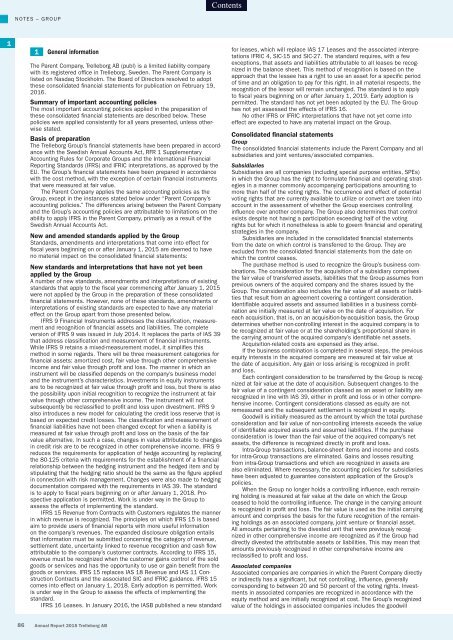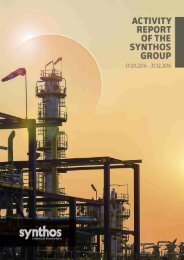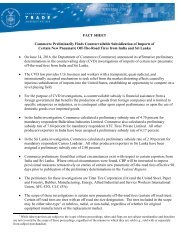We seal damp and protect
1o0Rrof
1o0Rrof
You also want an ePaper? Increase the reach of your titles
YUMPU automatically turns print PDFs into web optimized ePapers that Google loves.
NOTES – GROUP<br />
1<br />
18<br />
19<br />
20<br />
21<br />
22<br />
23<br />
24<br />
25<br />
26<br />
1 General information<br />
The Parent Company, Trelleborg AB (publ) is a limited liability company<br />
with its registered office in Trelleborg, Sweden. The Parent Company is<br />
listed on Nasdaq Stockholm. The Board of Directors resolved to adopt<br />
these consolidated financial statements for publication on February 19,<br />
2016.<br />
Summary of important accounting policies<br />
The most important accounting policies applied in the preparation of<br />
these consolidated financial statements are described below. These<br />
policies were applied consistently for all years presented, unless otherwise<br />
stated.<br />
Basis of preparation<br />
The Trelleborg Group’s financial statements have been prepared in accordance<br />
with the Swedish Annual Accounts Act, RFR 1 Supplementary<br />
Accounting Rules for Corporate Groups <strong>and</strong> the International Financial<br />
Reporting St<strong>and</strong>ards (IFRS) <strong>and</strong> IFRIC interpretations, as approved by the<br />
EU. The Group’s financial statements have been prepared in accordance<br />
with the cost method, with the exception of certain financial instruments<br />
that were measured at fair value.<br />
The Parent Company applies the same accounting policies as the<br />
Group, except in the instances stated below under “Parent Company’s<br />
accounting policies.” The differences arising between the Parent Company<br />
<strong>and</strong> the Group’s accounting policies are attributable to limitations on the<br />
ability to apply IFRS in the Parent Company, primarily as a result of the<br />
Swedish Annual Accounts Act.<br />
New <strong>and</strong> amended st<strong>and</strong>ards applied by the Group<br />
St<strong>and</strong>ards, amendments <strong>and</strong> interpretations that come into effect for<br />
fiscal years beginning on or after January 1, 2015 are deemed to have<br />
no material impact on the consolidated financial statements:<br />
New st<strong>and</strong>ards <strong>and</strong> interpretations that have not yet been<br />
applied by the Group<br />
A number of new st<strong>and</strong>ards, amendments <strong>and</strong> interpretations of existing<br />
st<strong>and</strong>ards that apply to the fiscal year commencing after January 1, 2015<br />
were not applied by the Group in the preparation of these consolidated<br />
financial statements. However, none of these st<strong>and</strong>ards, amendments or<br />
interpretations of existing st<strong>and</strong>ards are expected to have any material<br />
effect on the Group apart from those presented below.<br />
IFRS 9 Financial Instruments addresses the classification, measurement<br />
<strong>and</strong> recognition of financial assets <strong>and</strong> liabilities. The complete<br />
version of IFRS 9 was issued in July 2014. It replaces the parts of IAS 39<br />
that address classification <strong>and</strong> measurement of financial instruments.<br />
While IFRS 9 retains a mixed-measurement model, it simplifies this<br />
method in some regards. There will be three measurement categories for<br />
financial assets: amortized cost, fair value through other comprehensive<br />
income <strong>and</strong> fair value through profit <strong>and</strong> loss. The manner in which an<br />
instrument will be classified depends on the company’s business model<br />
<strong>and</strong> the instrument’s characteristics. Investments in equity instruments<br />
are to be recognized at fair value through profit <strong>and</strong> loss, but there is also<br />
the possibility upon initial recognition to recognize the instrument at fair<br />
value through other comprehensive income. The instrument will not<br />
subsequently be reclassified to profit <strong>and</strong> loss upon divestment. IFRS 9<br />
also introduces a new model for calculating the credit loss reserve that is<br />
based on expected credit losses. The classification <strong>and</strong> measurement of<br />
financial liabilities have not been changed except for when a liability is<br />
measured at fair value through profit <strong>and</strong> loss on the basis of the fair<br />
value alternative. In such a case, changes in value attributable to changes<br />
in credit risk are to be recognized in other comprehensive income. IFRS 9<br />
reduces the requirements for application of hedge accounting by replacing<br />
the 80-125 criteria with requirements for the establishment of a financial<br />
relationship between the hedging instrument <strong>and</strong> the hedged item <strong>and</strong> by<br />
stipulating that the hedging ratio should be the same as the figure applied<br />
in connection with risk management. Changes were also made to hedging<br />
documentation compared with the requirements in IAS 39. The st<strong>and</strong>ard<br />
is to apply to fiscal years beginning on or after January 1, 2018. Prospective<br />
application is permitted. Work is under way in the Group to<br />
assess the effects of implementing the st<strong>and</strong>ard.<br />
IFRS 15 Revenue from Contracts with Customers regulates the manner<br />
in which revenue is recognized. The principles on which IFRS 15 is based<br />
aim to provide users of financial reports with more useful information<br />
on the company’s revenues. The exp<strong>and</strong>ed disclosure obligation entails<br />
that information must be submitted concerning the category of revenue,<br />
settlement date, uncertainty linked to revenue recognition <strong>and</strong> cash flow<br />
attributable to the company’s customer contracts. According to IFRS 15,<br />
revenue must be recognized when the customer gains control of the sold<br />
goods or services <strong>and</strong> has the opportunity to use or gain benefit from the<br />
goods or services. IFRS 15 replaces IAS 18 Revenue <strong>and</strong> IAS 11 Construction<br />
Contracts <strong>and</strong> the associated SIC <strong>and</strong> IFRIC guidance. IFRS 15<br />
comes into effect on January 1, 2018. Early adoption is permitted. Work<br />
is under way in the Group to assess the effects of implementing the<br />
st<strong>and</strong>ard.<br />
IFRS 16 Leases. In January 2016, the IASB published a new st<strong>and</strong>ard<br />
for leases, which will replace IAS 17 Leases <strong>and</strong> the associated interpretations<br />
IFRIC 4, SIC-15 <strong>and</strong> SIC-27. The st<strong>and</strong>ard requires, with a few<br />
exceptions, that assets <strong>and</strong> liabilities attributable to all leases be recognized<br />
in the balance sheet. This method of recognition is based on the<br />
approach that the lessee has a right to use an asset for a specific period<br />
of time <strong>and</strong> an obligation to pay for this right. In all material respects, the<br />
recognition of the lessor will remain unchanged. The st<strong>and</strong>ard is to apply<br />
to fiscal years beginning on or after January 1, 2019. Early adoption is<br />
permitted. The st<strong>and</strong>ard has not yet been adopted by the EU. The Group<br />
has not yet assessed the effects of IFRS 16.<br />
No other IFRS or IFRIC interpretations that have not yet come into<br />
effect are expected to have any material impact on the Group.<br />
Consolidated financial statements<br />
Group<br />
The consolidated financial statements include the Parent Company <strong>and</strong> all<br />
subsidiaries <strong>and</strong> joint ventures/associated companies.<br />
Subsidiaries<br />
Subsidiaries are all companies (including special purpose entities, SPEs)<br />
in which the Group has the right to formulate financial <strong>and</strong> operating strategies<br />
in a manner commonly accompanying participations amounting to<br />
more than half of the voting rights. The occurrence <strong>and</strong> effect of potential<br />
voting rights that are currently available to utilize or convert are taken into<br />
account in the assessment of whether the Group exercises controlling<br />
influence over another company. The Group also determines that control<br />
exists despite not having a participation exceeding half of the voting<br />
rights but for which it nonetheless is able to govern financial <strong>and</strong> operating<br />
strategies in the company.<br />
Subsidiaries are included in the consolidated financial statements<br />
from the date on which control is transferred to the Group. They are<br />
excluded from the consolidated financial statements from the date on<br />
which the control ceases.<br />
The purchase method is used to recognize the Group’s business combinations.<br />
The consideration for the acquisition of a subsidiary comprises<br />
the fair value of transferred assets, liabilities that the Group assumes from<br />
previous owners of the acquired company <strong>and</strong> the shares issued by the<br />
Group. The consideration also includes the fair value of all assets or liabilities<br />
that result from an agreement covering a contingent consideration.<br />
Identifiable acquired assets <strong>and</strong> assumed liabilities in a business combination<br />
are initially measured at fair value on the date of acquisition. For<br />
each acquisition, that is, on an acquisition-by-acquisition basis, the Group<br />
determines whether non-controlling interest in the acquired company is to<br />
be recognized at fair value or at the shareholding’s proportional share in<br />
the carrying amount of the acquired company’s identifiable net assets.<br />
Acquisition-related costs are expensed as they arise.<br />
If the business combination is completed in several steps, the previous<br />
equity interests in the acquired company are measured at fair value at<br />
the date of acquisition. Any gain or loss arising is recognized in profit<br />
<strong>and</strong> loss.<br />
Each contingent consideration to be transferred by the Group is recognized<br />
at fair value at the date of acquisition. Subsequent changes to the<br />
fair value of a contingent consideration classed as an asset or liability are<br />
recognized in line with IAS 39, either in profit <strong>and</strong> loss or in other comprehensive<br />
income. Contingent considerations classed as equity are not<br />
remeasured <strong>and</strong> the subsequent settlement is recognized in equity.<br />
Goodwill is initially measured as the amount by which the total purchase<br />
consideration <strong>and</strong> fair value of non-controlling interests exceeds the value<br />
of identifiable acquired assets <strong>and</strong> assumed liabilities. If the purchase<br />
consideration is lower than the fair value of the acquired company’s net<br />
assets, the difference is recognized directly in profit <strong>and</strong> loss.<br />
Intra-Group transactions, balance-sheet items <strong>and</strong> income <strong>and</strong> costs<br />
for intra-Group transactions are eliminated. Gains <strong>and</strong> losses resulting<br />
from intra-Group transactions <strong>and</strong> which are recognized in assets are<br />
also eliminated. Where necessary, the accounting policies for subsidiaries<br />
have been adjusted to guarantee consistent application of the Group’s<br />
policies.<br />
When the Group no longer holds a controlling influence, each remaining<br />
holding is measured at fair value at the date on which the Group<br />
ceased to hold the controlling influence. The change in the carrying amount<br />
is recognized in profit <strong>and</strong> loss. The fair value is used as the initial carrying<br />
amount <strong>and</strong> comprises the basis for the future recognition of the remaining<br />
holdings as an associated company, joint venture or financial asset.<br />
All amounts pertaining to the divested unit that were previously recognized<br />
in other comprehensive income are recognized as if the Group had<br />
directly divested the attributable assets or liabilities. This may mean that<br />
amounts previously recognized in other comprehensive income are<br />
reclassified to profit <strong>and</strong> loss.<br />
Associated companies<br />
Associated companies are companies in which the Parent Company directly<br />
or indirectly has a significant, but not controlling, influence, generally<br />
corresponding to between 20 <strong>and</strong> 50 percent of the voting rights. Investments<br />
in associated companies are recognized in accordance with the<br />
equity method <strong>and</strong> are initially recognized at cost. The Group’s recognized<br />
value of the holdings in associated companies includes the goodwill<br />
86 Annual Report 2015 Trelleborg AB






